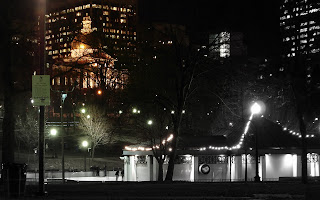
HISTORY
Boston grew up from a shipping center situated on the Harbor to a Metropolis that serves as the hub of a region. Today the Boston Common is many things. It's the front yard of the Massachusetts State House and Beacon Hill, It's the campus of Suffolk University and Emerson College. The Boston Common is the anchor of the Emerald Necklace linear park system of Boston, which today stretches seven miles through Boston to Franklin Park.
GEOGRAPHY
The Boston Common was also once the edge of the city and a natural barrier to direct the flow of Boston's commercial development away from the residential neighborhoods of the aristocratic Yankees neighborhoods of Beacon Hill and also the Back Bay. Using the legislative power of the state rather than the city, the aristocratic Yankees in Boston have a legacy of shaping Boston's physical development. When state legislation preserved the Boston Common as open space for all ime the Yankees had found a way to stop running from the commercial activity which was sweeping out across Boston.BOSTON VS NEW YORK When Boston and New York City were both experiencing explosive growth and commercial development throughout the 19th century the residential neighborhoods were constantly getting pushed to new locations in each respective city. You can imagine this growth flowing from the ports out in each city so in Boston it centered around the harbor and especially at State Street. In New York City it began at the foot of Manhattan's 'Downtown' and flowed 'Uptown' along Broadway. Over the course of the century the residential enclaves of each city was being invaded by commercial activity which could produce more income than residential use that was also destructive to an urban neighborhood's residential nature. The story of this expansion and government intervention illustrate an interesting difference between Boston and NYC. In New York City the political will was pro-growth and the residential neighborhoods spent the 19th Century moving uptown, eventually building a residential stronghold uptown, starting along Central Park. In Boston the influential Yankee residents were able to protect their neighborhoods instead. Through the authority of the state government the Yankees preserved a residential enclave on Beacon Hill and legislation was passed preserving the open space of the Boston Common. Not only did this create a vital organ of open space to improve the quality of city life but more interestingly it diverted the flow of commercial development away from residential neighborhoods where Beacon Hill and the Back Bay still stand today, a testamant to the power of the residents over the businesses there and also of the state authority in Boston over municipal authority.
WHAT TO DO
Shopping in the vibrant and teaming Downtown Crossing, enjoying Asian cuisine and culture in Chinatown, enjoying shows in the theater district, or the 24 hour life-style of the Back Bay are all just minutes walk from the Boston Common. But Boston Common is also a powerful symbol of freedom where you are sure to find drug addicts and homeless, demonstrators and street preachers, musicians, plays and movie sets. Over the years cattle has grazed there, bodies were buried
 there and Martin Luther King Jr., among others, has spoken. For night life check out 'the alley' on Boylston Street along the Boston Common. And Downtown Crossing has also began to wake up after years of quiet nights, with newly restored theaters, and and a steadily growing nightlife as a growing number of pioneers join the students and homeless in the neighborhood.
there and Martin Luther King Jr., among others, has spoken. For night life check out 'the alley' on Boylston Street along the Boston Common. And Downtown Crossing has also began to wake up after years of quiet nights, with newly restored theaters, and and a steadily growing nightlife as a growing number of pioneers join the students and homeless in the neighborhood.For the intellectual types, check out the monuments around the State House, the mansions of the Beacon Hill (some of which are open to the public) and best of all The Brattle Book Shop on West Street, the best used book store in the city where a vacant lot next to the shop serves as a open air market filled with $5, $3 and my favorite $1 books on all topics. Take note that Park Street station is the nation's oldest continually operating subway stop. Take a look at the historic churches, landmarks of
 medical history, and burying grounds along Tremont Street where you can follow the freedom trail deeper into old Boston.Take a break while walking through the Boston Common at the soldiers and sailors civil war monument. The column is covered in sculpture and raises 126 feet on top of a hill, providing a great place to sit and gaze upon the city lights and sights.
medical history, and burying grounds along Tremont Street where you can follow the freedom trail deeper into old Boston.Take a break while walking through the Boston Common at the soldiers and sailors civil war monument. The column is covered in sculpture and raises 126 feet on top of a hill, providing a great place to sit and gaze upon the city lights and sights.When you look to your left, when you look to your right, you might find the Wicked Bostoner Sitting beside y
 ou.
ou.












 of
of 





No comments:
Post a Comment